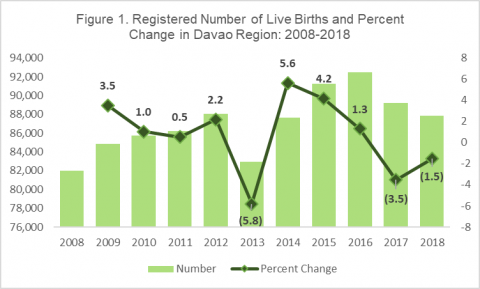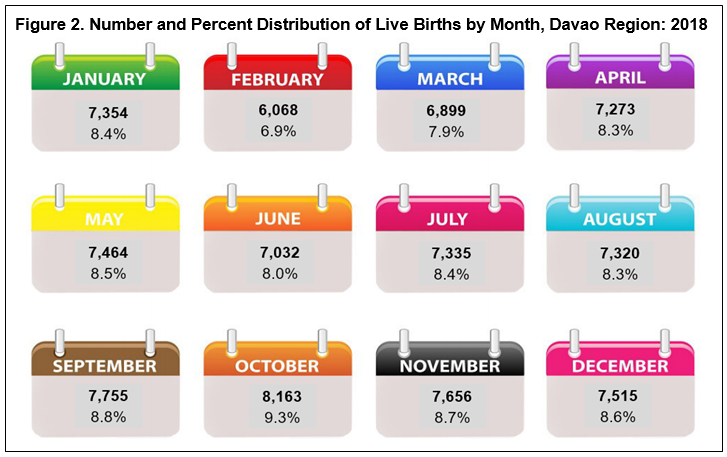Release Date :
Reference Number :
2020-017
 An average of 241 registered babies born daily in the region
An average of 241 registered babies born daily in the regionA total of 87,834 live births was registered in Davao Region in 2018 which is equivalent to a crude birth rate (CBR) of 17.1 or 17 births per thousand population. On the average, there were about 241 registered babies born daily or 10 babies per hour.
The number of registered live births from 2008 to 2016 showed an increasing trend, except in the year 2013. There was a decreasing trend from 2016 to 2018 (Figure 1 and Table 1).
In the region, more than half (52.0%) of the babies registered were males (45,662), while females comprised of 42,172 or 48.0 percent. This resulted to a sex ratio of 108 male babies per 100 female babies.
Most births occur in October
In 2018, most of registered births occurred in October (9.3%), followed by the months of September and November with 8.8 percent and 8.7 percent, respectively.
On the other hand, the month of February had the least number of births at 6.9 percent (Figure 2).

Highest occurrence of birth in Davao City
Among the provinces and Highly Urbanized City in Davao Region, Davao City recorded the highest number of registered birth occurrences in 2018 at 40.1 percent (35,242) followed by Davao del Norte with 26.0 percent or 22,793 births (Figure 3).

The provinces of Compostela Valley, Davao del Sur and Davao Oriental have registered live births of 10,678, 10,525 and 7,166, respectively.
On the other hand, Davao Occidental had the least registered number of live births at 1.6 percent (1,430).
More registered babies born outside the usual place of residence of the mother in Davao del Norte and Davao City
Davao del Norte and Davao City reported to have higher number of registered babies born outside the usual place of residence of the mother in 2018. Davao del Norte reported positive differentials of 3,507 births, while 3,097 for Davao City (Table 2).
These positive differentials may be indicative of expectant mothers’ preference to give birth outside their usual place of residence and avail better services in existing health facilities of these receiving areas.
On the other hand, provinces with negative differentials indicated that there were more mothers that had given birth outside their usual place of residence. Compostela Valley registered the largest negative differential with a total of 2,070, and followed by Davao Oriental with 1,510.
Davao Region is considered as a receiving region or a preference of expectant mothers from neighboring regions, which brought a positive differential in the number of births by place of occurrence when compared to the number of births by usual residence of the mother.
Nine out of ten births attended by health professionals
Nine out of ten deliveries of registered birth in Davao Region were attended by medical professionals such as physicians, nurses or midwives (Figure 4).
It is worth to note that births attended by health professionals is increasing in three (3) year-period (93.0% in 2016, 95.1% in 2017 and 96.8% in 2018).

There were 2,722 births which were attended by traditional birth attendants (hilot/unlicensed midwife) while the remaining share was served by other attendants at birth.
The births attended by traditional birth attendants decreased from 4.3 percent in 2017 to 3.1 percent in 2018.
Among provinces including the Highly Urbanized City in Davao Region, Davao City had registered the highest proportion of birth deliveries attended by medical professionals at 98.3 percent. This was followed by Compostela Valley (97.0%) and Davao del Norte (96.5%) (Table 3).
Davao Occidental had the least proportion of births attended by health professionals at 79.4 percent. One out of five (20.5%) birth deliveries in this province was attended by traditional birth attendants.
More than half of the registered babies born to unwed mothers
More than half (50,082 or 58.1%) of live births whose mothers are residents of Davao Region were born out of wedlock. These birth occurrences in Davao Region contributed a 5.5 percent share to the national total number of illegitimate children in 2018.
EXPLANATORY NOTES
Data on births presented in this release were obtained from the Certificates of Live Birth (Municipal Form No. 102) that were registered at the Office of the City/Municipal Civil Registrars in Davao Region and forwarded to the Philippine Statistics Authority. Information presented includes registered births which occurred from January to December 2018.
Live Birth is a complete expulsion or extraction from its mother of a product of conception, irrespective of the duration of the pregnancy, which after such separation, breathes or shows any other evidence of life, such as beating of the heart, pulsation of the umbilical cord, or definite movement of voluntary muscles, whether or not the umbilical cord has been cut or the placenta is attached; each product of such birth is considered live born.
SUPPORT THE 2015-2024 CRVS DECADE
President Benigno S. Aquino III signed Proclamation No. 1106 on August 20, 2015 which declared the years 2015 to 2024 as Civil Registration and Vital Statistics Decade (CRVS). Said proclamation is a concrete manifestation of the Philippine government’s support to the outcome of the Ministerial Conference on CRVS in Asia and the Pacific held in November 2014 in Bangkok, Thailand.
PEPITO D. AMOYEN
OIC-Regional Director
STATISTICAL TABLES



